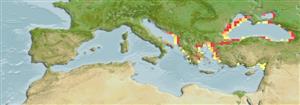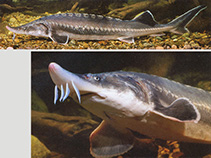個人による観察記録の追加 Fish Watcher
| Native range | All suitable habitat | Point map | Year 2050 |

|
| This map was computer-generated and has not yet been reviewed. |
| Huso huso AquaMaps Data sources: GBIF OBIS |
Romania country information
Common names:
Morun
Occurrence: native
Salinity: freshwater
Abundance: | Ref:
Importance: | Ref:
Aquaculture: | Ref:
Regulations: | Ref:
Uses: no uses
Comments:
National Checklist:
Country Information: https://www.cia.gov/library/publications/resources/the-world-factbook/geos/ro.html
National Fisheries Authority:
Occurrences: Occurrences Point map
Main Ref: Blanc, M., J.-L. Gaudet, P. Banarescu and J.-C. Hureau, 1971
National Database: Animalia Eukarya - Romania
Occurrence: native
Salinity: freshwater
Abundance: | Ref:
Importance: | Ref:
Aquaculture: | Ref:
Regulations: | Ref:
Uses: no uses
Comments:
National Checklist:
Country Information: https://www.cia.gov/library/publications/resources/the-world-factbook/geos/ro.html
National Fisheries Authority:
Occurrences: Occurrences Point map
Main Ref: Blanc, M., J.-L. Gaudet, P. Banarescu and J.-C. Hureau, 1971
National Database: Animalia Eukarya - Romania
Common names from other countries
分類 / Names 共通名の | 類義語 | Catalog of Fishes(部類, 種) | ITIS | CoL | WoRMS | Cloffa
> Acipenseriformes (Sturgeons and paddlefishes) > Acipenseridae (Sturgeons) > Acipenserinae
Etymology: Huso: Latin, huso = swine (Ref. 45335).
More on author: Linnaeus.
Etymology: Huso: Latin, huso = swine (Ref. 45335).
More on author: Linnaeus.
Environment: milieu / climate zone / depth range / distribution range 生態学
海; 新鮮な水; 汽水性の; 昇流魚 (Ref. 51243); 深さの範囲 70 - 180 m. Temperate; 10°C - 20°C (Ref. 2059); 57°N - 35°N, 13°E - 60°E
分布 国々 | 国連食糧農業機関の区域 | エコシステム | 事件 | Point map | 導入 | Faunafri
Eurasia: Caspian, Black, Azov and Adriatic Sea basins.
Extirpated from Adriatic Sea.
Length at first maturity / サイズ / 重さ / 年齢
Maturity: Lm ?, range 200 - ? cm
Max length : 800 cm TL オス/雌雄の選別がない; (Ref. 59043); common length : 215 cm TL オス/雌雄の選別がない; (Ref. 3397); 最大公表体重: 3.2 t (Ref. 59043); 最大記録サイズ: 118 年 (Ref. 47437)
Max length : 800 cm TL オス/雌雄の選別がない; (Ref. 59043); common length : 215 cm TL オス/雌雄の選別がない; (Ref. 3397); 最大公表体重: 3.2 t (Ref. 59043); 最大記録サイズ: 118 年 (Ref. 47437)
簡単な記述 検索表 | 形態学 | 形態計測学
背面の脊椎 (合計) : 0; 背鰭 (合計) : 62 - 73; 肛門の骨: 0; 臀鰭: 28 - 41. Snout moderate and pointed, turning slightly upward. Lower lip not continuous, interrupted at center. Barbels oval or flat, leaf-like posteriorly, reaching almost to mouth. Five rows of scutes, dorsal 11-14 (first one smallest), lateral 41-52 on each side, ventral 9-11 on each side. Back ash-grey or greenish, flanks lighter, belly white.
Pelagic at the sea, following its prey. Undertakes upriver migration to spawn. Juveniles occur in shallow riverine habitats during their first summer. Spawns in the main course of large and deep rivers with strong current and on stone or gravel bottom (Ref. 59043). Feeds mostly on sea fishes (Black Sea whiting, anchovies, flatfishes, gobies, fry of bottom-living fishes), also crustaceans, mollusks, mysids and amphipods. Fisheries are based almost entirely on the value of the caviar, but meat also is sold fresh, smoked and frozen; eaten broiled, boiled, fried and baked (Ref. 9988). Bester, a hybrid of female Huso huso and male sterlet Acipenser ruthenus, has been successfully cultivated for its high quality eggs (Ref. 9988). The largest sturgeon and largest European freshwater fish. In Guinness Book of Records as the most expensive fish (Ref. 6472). Threatened due to overfishing for meat at the sea and for caviar in estuaries. These threats will soon cause global extinction of the natural populations. Survival can only depend on stocking (Ref. 59043).
Life cycle and mating behavior 成熟 | 繁殖 | 放精 | 卵 | 生産力 | 幼生
Enters rivers from March, usually April and May (also in autumn). Survives largely by artificial propagation. About 360,000-7,700,000 eggs per female. Females carry eggs only once every five to seven years (Ref. 9988).
主な参考文献
Upload your references | 参考文献 | コーディネーター | 協力者
Kottelat, M. and J. Freyhof, 2007. Handbook of European freshwater fishes. Publications Kottelat, Cornol and Freyhof, Berlin. 646 pp. (Ref. 59043)
IUCNのレッドリストの状況は (Ref. 130435: Version 2024-2)
絶滅寸前の危機的状況 (CR) (A2bcd); Date assessed: 14 September 2019
人間に対する脅威
Harmless
Human uses
水産業: 商業; 水産養殖: 商業
より多くの情報
Population dynamics
成長のパラメーター
Max. ages / sizes
Length-weight rel.
Length-length rel.
体長組成
Mass conversion
補充
豊度
成長のパラメーター
Max. ages / sizes
Length-weight rel.
Length-length rel.
体長組成
Mass conversion
補充
豊度
Anatomy
カマ
Brain
Otolith
カマ
Brain
Otolith
Physiology
Body composition
Nutrients
酸素消費
水泳形態
泳ぐ速さ
Visual pigments
Fish sound
Diseases & Parasites
Toxicity (LC50s)
Body composition
Nutrients
酸素消費
水泳形態
泳ぐ速さ
Visual pigments
Fish sound
Diseases & Parasites
Toxicity (LC50s)
用具
E-book | 野外観察図鑑 | 検索表 | Length-frequency wizard | 生活史の基盤ツール | 目的のマップ | Classification Tree
| Catch-MSY |
特記事項
XMLをダウンロードして下さい
インターネットの情報源
Alien/Invasive Species database | Aquatic Commons | BHL | Cloffa | BOLDSystems | Websites from users | Check FishWatcher | CISTI | Catalog of Fishes(部類, 種) | DiscoverLife | ECOTOX | Faunafri | Fishtrace | GenBank(ゲノム, ヌクレオチド) | GloBI | GOBASE | | Google Books | Google Scholar | Google | IGFA World Record | MitoFish | 国のデーターベース | Otolith Atlas of Taiwan Fishes | PubMed | Reef Life Survey | Scirus | SeaLifeBase | 生命の木 | Wikipedia(行く, 検索する) | World Records Freshwater Fishing | 動物に関する記録
Estimates based on models
Preferred temperature (Ref. 115969): 7.7 - 15.6, mean 9.1 (based on 19 cells).
Phylogenetic diversity index (Ref. 82804): PD50 = 0.7500 [Uniqueness, from 0.5 = low to 2.0 = high].
Bayesian length-weight: a=0.00427 (0.00257 - 0.00707), b=3.12 (2.98 - 3.26), in cm Total Length, based on LWR estimates for this species & (Sub)family-body (Ref. 93245).
栄養段階 (Ref. 69278): 4.4 ±0.3 se; based on diet studies.
回復力 (Ref. 120179): 非常に低い, 14年以上の倍増期間の最小個体群 (K=0.1; tm=13-22; tmax=118; Fec=360,000).
Fishing Vulnerability (Ref. 59153): Very high vulnerability (89 of 100).
Climate Vulnerability (Ref. 125649): Very high vulnerability (79 of 100).




